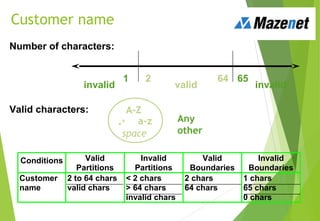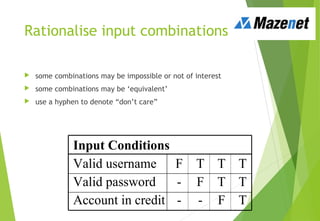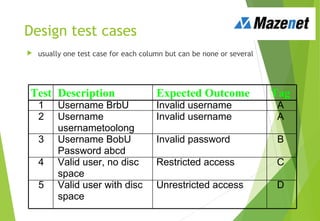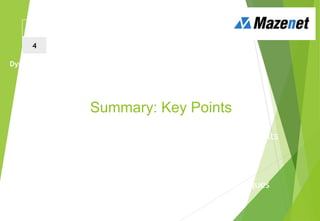Software Testing-Dynamic testing technique-Mazenet solution
- 1. Dynamic Testing Techniques Presented by E Baskaran (Testing Trainer)
- 2. Dynamic Testing Techniques 1 Principles 2 Lifecycle 4 Dynamic test techniques 3 Static testing 5 Management 6 Tools Software Testing Chapter 4
- 3. Contents What is a testing technique? Black and White box testing Black box test techniques White box test techniques Error Guessing Dynamic Testing Techniques 1 2 3 4 5 6
- 4. Why dynamic test techniques? Exhaustive testing (use of all possible inputs and conditions) is impractical must use a subset of all possible test cases must have high probability of detecting faults Need thought processes that help us select test cases more intelligently test case design techniques are such thought processes
- 5. What is a testing technique? a procedure for selecting or designing tests based on a structural or functional model of the software successful at finding faults 'best' practice a way of deriving good test cases a way of objectively measuring a test effort Testing should be rigorous, thorough and systematicTesting should be rigorous, thorough and systematic
- 6. Using techniques makes testing much more effectiveUsing techniques makes testing much more effective Advantages of techniques Different people: similar probability find faults gain some independence of thought Effective testing: find more faults focus attention on specific types of fault know you're testing the right thing Efficient testing: find faults with less effort avoid duplication systematic techniques are measurable
- 7. Measurement Objective assessment of thoroughness of testing (with respect to use of each technique) useful for comparison of one test effort to another E.g. Project A 60% Equivalence partitions 50% Boundaries 75% Branches Project B 40% Equivalence partitions 45% Boundaries 60% Branches
- 8. Contents What is a testing technique? Black and White box testing Black box test techniques White box test techniques Error Guessing Dynamic Testing Techniques 1 2 3 4 5 6
- 9. Three types of systematic technique Static (non-execution) • examination of documentation, source code listings, etc. Functional (Black Box) • based on behaviour / functionality of software Structural (White Box) • based on structure of software
- 10. Some test techniques StaticStatic DynamicDynamic StructuralStructural BehaviouralBehavioural FunctionalFunctionalNon-functionalNon-functional ReviewsReviews WalkthroughsWalkthroughs Desk-checkingDesk-checking Data Flow Data Flow Symbolic Execution Symbolic Execution Definition -Use Definition -Use StatementStatement Branch/DecisionBranch/Decision Branch ConditionBranch Condition Branch Condition Combination Branch Condition Combination LCSAJLCSAJ ArcsArcs Equivalence Partitioning Equivalence Partitioning Boundary Value Analysis Boundary Value Analysis Cause-Effect GraphingCause-Effect Graphing RandomRandom UsabilityUsability PerformancePerformance Static AnalysisStatic Analysis InspectionInspection Control Flow Control Flow etc.etc. etc.etc. etc.etc. etc.etc. etc.etc. State TransitionState Transition
- 11. Black box versus white box? IntegrationIntegration ComponentComponent AcceptanceAcceptance SystemSystem Black box appropriate at all levels but dominates higher levels of testing White box used predominately at lower levels to compliment black box
- 12. Contents What is a testing technique? Black and White box testing Black box test techniques White box test techniques Error Guessing Dynamic Testing Techniques 1 2 3 4 5 6
- 13. Black Box test design and measurement techniques Techniques defined in BS 7925-2 Equivalence partitioning Boundary value analysis State transition testing Cause-effect graphing Syntax testing Random testing Also defines how to specify other techniques = Yes = No Also a measurement technique?
- 14. Equivalence partitioning (EP) divide (partition) the inputs, outputs, etc. into areas which are the same (equivalent) assumption: if one value works, all will work one from each partition better than all from one 1 100 1010 valid invalidinvalid
- 15. Boundary value analysis (BVA) faults tend to lurk near boundaries good place to look for faults test values on both sides of boundaries 1 100 1010 valid invalidinvalid
- 16. Example: Loan application Customer Name Account number Loan amount requested Term of loan Monthly repayment Term: Repayment: Interest rate: Total paid back: 6 digits, 1st non-zero £500 to £9000 1 to 30 years Minimum £10 2-64 chars.
- 17. Customer name Number of characters: 2 64 65 invalid valid invalid 1 Conditions Valid Partitions Invalid Partitions Valid Boundaries Invalid Boundaries Customer name 2 to 64 chars valid chars < 2 chars > 64 chars invalid chars 2 chars 64 chars 1 chars 65 chars 0 chars Valid characters: Any other A-Z a-z-’ space
- 18. Account number 5 6 7 invalid valid invalid number of digits: first character: invalid: zero valid: non-zero Conditions Valid Partitions Invalid Partitions Valid Boundaries Invalid Boundaries Account number 6 digits 1st non-zero < 6 digits > 6 digits 1st digit = 0 non-digit 100000 999999 5 digits 7 digits 0 digits
- 19. Loan amount 500 9000 9001 invalid valid invalid 499 Conditions Valid Partitions Invalid Partitions Valid Boundaries Invalid Boundaries Loan amount 500 - 9000 < 500 >9000 0 non-numeric null 500 9000 499 9001
- 20. Condition template Conditions Valid Partitions Tag Invalid Partitions Tag Valid Boundaries Tag Invalid Boundaries Tag Customer name 2 - 64 chars valid chars V1 V2 < 2 chars > 64 chars invalid char X1 X2 X3 2 chars 64 chars B1 B2 1 char 65 chars 0 chars D1 D2 D3 Account number 6 digits 1st non-zero V3 V4 < 6 digits > 6 digits 1st digit = 0 non-digit X4 X5 X6 X7 100000 999999 B3 B4 5 digits 7 digits 0 digits D4 D5 D6 Loan amount 500 - 9000 V5 < 500 >9000 0 non-integer null X8 X9 X10 X11 X12 500 9000 B5 B6 499 9001 D7 D8
- 21. Design test cases Test Case Description Expected Outcome New Tags Covered 1 2 Name: John Smith Acc no: 123456 Loan: 2500 Term: 3 years Name: AB Acc no: 100000 Loan: 500 Term: 1 year Term: 3 years Repayment: 79.86 Interest rate: 10% Total paid: 2874.96 Term: 1 year Repayment: 44.80 Interest rate: 7.5% Total paid: 537.60 V1, V2, V3, V4, V5 ..... B1, B3, B5, .....
- 22. Why do both EP and BVA? If you do boundaries only, you have covered all the partitions as well technically correct and may be OK if everything works correctly! if the test fails, is the whole partition wrong, or is a boundary in the wrong place - have to test mid-partition anyway testing only extremes may not give confidence for typical use scenarios (especially for users) boundaries may be harder (more costly) to set up
- 23. Test objectives? For a thorough approach: VP, IP, VB, IB Under time pressure, depends on your test objective - minimal user-confidence: VP only?minimal user-confidence: VP only? - maximum fault finding: VB first (plus IB?)maximum fault finding: VB first (plus IB?) Condition Valid Partition Tag Invalid Partition Tag Valid Boundary Tag Invalid Boundary Tag
- 24. Decision tables explore combinations of inputs, situations or events, it is very easy to overlook specific combinations of input start by expressing the input conditions of interest so that they are either TRUE or FALSE – record found – file exists – code valid – policy expired – account in credit – due date > current date
- 25. Example: student access A university computer system allows students an allocation of disc space depending on their projects. If they have used all their allotted space, they are only allowed restricted access, i.e. to delete files, not to create them. This is assuming they have logged on with a valid username and password. What are the input and output conditions?What are the input and output conditions?
- 26. List the input and output conditions • list the ‘output conditions’ under the input conditions Input Conditions Valid username Valid password Account in credit Output Conditions Login accepted Restricted access • list the ‘input conditions’ in the first column of the table
- 27. Determine input combinations add columns to the table for each unique combination of input conditions. each entry in the table may be either ‘T’ for true, ‘F’ for false. Input Conditions Valid username T T T T F F F F Valid password T T F F T T F F Account in credit T F T F T F T F
- 28. Rationalise input combinations some combinations may be impossible or not of interest some combinations may be ‘equivalent’ use a hyphen to denote “don’t care” Input Conditions Valid username F T T T Valid password - F T T Account in credit - - F T
- 29. Complete the table determine the expected output conditions for each combination of input conditions Input Conditions Valid username F T T T Valid password - F T T Account in credit - - F T Output Conditions Login accepted F F T T Restricted access - - T F
- 30. Determine test case groups each column is at least one test case Input Conditions Valid username F T T T Valid password - F T T Account in credit - - F T Output Conditions Login accepted F F T T Restricted access - - T F Tags A B C D
- 31. Design test cases usually one test case for each column but can be none or several Test Description Expected Outcome Tag 1 Username BrbU Invalid username A 2 Username usernametoolong Invalid username A 3 Username BobU Password abcd Invalid password B 4 Valid user, no disc space Restricted access C 5 Valid user with disc space Unrestricted access D
- 32. Rationalising outputs if outputs or effects are mutually exclusive, I.e. T occurs in only one place in each column, we can combine them for example: X T F F Y F T F Z F F T Output X Y Z is equivalent to:
- 33. Rationalising dangers rationalising is based on assumptions assumptions may be wrong! assumptions should be stated assumptions may change over time be aware of the dangers filling in the full table may find errors which will be missed if you rationalise it is possible to rationalise too far
- 34. Extending decision tables Entries can be more than just ‘true’ or ‘false’ completing table needs to be done carefully rationalising becomes more important E.g. Code = 1, 2, or 3 1 1 1 1 2 2 2 2 3 3 3 3 Exp.date < now T T F F T T F F T T F F Class A product T F T F T F T F T F T F
- 35. Decision Tables in relation to EP and BVA Input value Output value FALSE TRUE
- 36. Contents What is a testing technique? Black and White box testing Black box test techniques White box test techniques Error Guessing Dynamic Testing Techniques 1 2 3 4 5 6
- 37. White Box test design and measurement techniques Techniques defined in BS 7925-2 Statement testing Branch / Decision testing Data flow testing Branch condition testing Branch condition combination testing Modified condition decision testing LCSAJ testing Also defines how to specify other techniques = Yes = No Also a measurement technique?
- 38. Stronger structural techniques (different structural elements) More tests Using structural coverage Increasing coverage Coverage OK? What's covered ? Results OK? Enough tests? Spe c Spe c SoftwareSoftware Tests More testsMore testsMore testsMore testsMore testsMore testsMore tests
- 39. The test coverage trap Structure exercised, insufficient function Structure exercised, insufficient function Function exercised, insufficient structure Function exercised, insufficient structure better testingbetter testing % Statement % Decision % Condition Combination Structural testedness Functional testedness 100% coverage does not mean 100% tested! 100% coverage does not mean 100% tested! Coverage is not Thoroughness Coverage is not Thoroughness
- 40. Statement coverage percentage of executable statements exercised by a test suite number of statements exercised total number of statements example: program has 100 statements tests exercise 87 statements statement coverage = 87% = Typical ad hoc testing achieves 60 - 75%Typical ad hoc testing achieves 60 - 75% Statement coverage is normally measured by a software tool. Statement coverage is normally measured by a software tool. ?
- 41. Example of statement coverage Test case Input Expected output 1 7 7 As all 5 statements are ‘covered’ by this test case, we have achieved 100% statement coverage read(a) IF a > 6 THEN b = a ENDIF print b 1 2 3 4 5 Statement numbers
- 42. Decision coverage (Branch coverage) percentage of decision outcomes exercised by a test suite number of decisions outcomes exercised total number of decision outcomes example: program has 120 decision outcomes tests exercise 60 decision outcomes decision coverage = 50% Typical ad hoc testing achieves 40 - 60%Typical ad hoc testing achieves 40 - 60% = Decision coverage is normally measured by a software tool. Decision coverage is normally measured by a software tool. True False ?
- 43. Paths through code ? ? 1 2 ? ? 1 2 31 2 ? ? 1 2 3 4
- 44. Paths through code with loops ? 1 2 3 4 5 6 7 8 …. for as many times as it is possible to go round the loop (this can be unlimited, i.e. infinite)
- 45. End Select trans... Yes Example 1 Wait for card to be inserted IF card is a valid card THEN display “Enter PIN number” IF PIN is valid THEN select transaction ELSE (otherwise) display “PIN invalid” ELSE (otherwise) reject card End Display “Enter.. Yes Valid PIN? No Reject card Display “PIN in.. No Valid card? Wait
- 46. Read A IF A > 0 THEN IF A = 21 THEN Print “Key” ENDIF ENDIF IF A > 0 THEN ENDIF Print “Key” IF A = 21 THEN ENDIF Example 2 Cyclomatic complexity: _____ Minimum tests to achieve: Statement coverage: ______ Branch coverage: _____ 3 1 3 Read A Print Yes A=21 Yes No End A>0 No Read
- 47. Example 3 Cyclomatic complexity: _____ Minimum tests to achieve: Statement coverage: ______ Branch coverage: _____ Read A Read B IF A > 0 THEN IF B = 0 THEN Print “No values” ELSE Print B IF A > 21 THEN Print A ENDIF ENDIF ENDIF 4 2 4 Print Yes Print A>21 No No B=0 Print Yes Yes Read A>0 End No
- 48. Example 4 Cyclomatic complexity: _____ Minimum tests to achieve: Statement coverage: ______ Branch coverage: _____ Read A Read B IF A < 0 THEN Print “A negative” ELSE Print “A positive” ENDIF IF B < 0 THEN Print “B negative” ELSE Print “B positive” ENDIF 3 2 2 Read End Print No Print Yes B<0 Print No Print Yes A<0 Note: there are 4 paths
- 49. End No Example 5 Cyclomatic complexity: _____ Minimum tests to achieve: Statement coverage: ______ Branch coverage: _____ Read A Read B IF A < 0 THEN Print “A negative” ENDIF IF B < 0 THEN Print “B negative” ENDIF 3 1 2 Read A<0 Print Yes No B<0 Print Yes
- 50. Example 6 Cyclomatic complexity: _____ Minimum tests to achieve: Statement coverage: ______ Branch coverage: _____ Read A IF A < 0 THEN Print “A negative” ENDIF IF A > 0 THEN Print “A positive” ENDIF 3 2 2 Read Print Yes No End No A>0 Print Yes A<0
- 51. Contents What is a testing technique? Black and White box testing Black box test techniques White box test techniques Error Guessing Dynamic Testing Techniques 1 2 3 4 5 6
- 52. Non-systematic test techniques Trial and error / Ad hoc Error guessing / Experience-driven User Testing Unscripted Testing A testing approach that is only rigorous, thorough and systematic is incomplete A testing approach that is only rigorous, thorough and systematic is incomplete
- 53. Error-Guessing always worth including after systematic techniques have been used can find some faults that systematic techniques can miss a ‘mopping up’ approach supplements systematic techniques Not a good approach to start testing withNot a good approach to start testing with
- 54. Error Guessing: deriving test cases Consider: past failures intuition experience brain storming “What is the craziest thing we can do?”
- 55. Summary: Key Points Test techniques are ‘best practice’: help to find faults Black Box techniques are based on behaviour White Box techniques are based on structure Error Guessing supplements systematic techniques Dynamic Testing Techniques 1 2 3 4 5 6























































